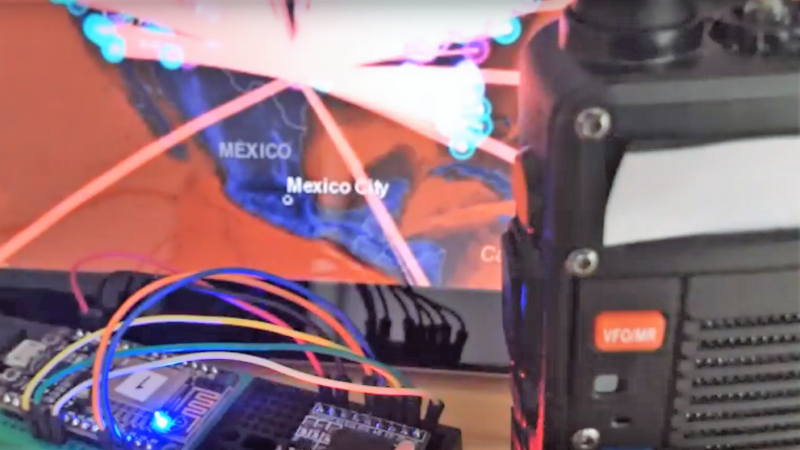For a hobby that’s ostensibly all about reaching out to touch someone, ham radio can often be a lonely activity. Lots of hams build and experiment with radio gear much more than they’re actually on the air, improving their equipment iteratively. The build-test-tweak-repeat cycle can get a little tedious, though, especially when you’re trying to assess signal strength and range and can’t find anyone to give you a report.
To close the loop on field testing, [WhiskeyTangoHotel] threw together a simple ham radio field confirmation unit that’s pretty slick. It relies on the fact that almost every ham radio designed for field use incorporates a DTMF encoder in the microphone or in the transceiver itself. Hams have used Touch Tones for in-band signaling control of their repeaters for decades, and even as newer digital control methods have been introduced, good old analog DTMF hangs in there. The device consists of a DTMF decoder attached to the headphone jack of a cheap handy talkie. When a DTMF tone is received, a NodeMCU connected to the decoder calls an IFTTT job to echo the key to [WTH]’s phone as an SMS message. That makes it easy to drive around and test whether his mobile rig is getting out. And since the receiver side is so portable, there’s a lot of flexibility in how tests can be arranged.
On the fence about ham as a hobby? We don’t blame you. But fun projects like this are the perfect excuse to go get licensed and start experimenting.
















I did something kinda similar but stationary. I used a simple DTMF decoder on my PC attached to a Baofeng UV-5R, wired to an external antenna on my second floor balcony and used Chrome Remote Desktop to see if my PC received it.
I do like the portability of this setup though. It gives me an idea though, can a similar version be crafted using an old android phone. Breath a little life into something that may be sitting in a junk drawer using some cheap prepaid service.
is possible to glue this with PPP and normal linux interfaces?
ssh trought baofeng ;-)
DTMF over a radio link or heck over a phone line is a cool way to control stuff.
Back in the day I (in improper operating form, as FRS rules say this is a no-no) used DTMF over an FRS radio link to give me additional controls on board a wheeled ROV I built.
It amazes me that this old site is still there:
http://www.arrickrobotics.com/robomenu/probesg.html
OH MAN!!!! Arrick Robotics was the best!!! I have an ARobot sitting on my shelf. That was my first real introduction to robotics and the embedded world. Good memories… maybe I’ll upgrade it with a modern MCU and peripherals one of these days.
This is one standalone take on the same idea, except the transceiver at the other end answers.
But if it is connected to a better antenna and has more power, you should be able to hear it for longer than it can hear you on the handheld.
https://www.youtube.com/watch?v=rYs09eJiaKY
Here’s the build guide, schematic starts on 4:40
https://www.youtube.com/watch?v=VD8p2pcTCp4
I read “SOLO HAM” as Han Solo…
Yeah, you would, Ren, wouldn’t you?
Search for: Simplex repeater. You hear back what the base station received right after you let go of PTT. Useful because it allows you to hear the “bacon frying” or picket fencing as your signal gets weak or if you are moving and there is fading. The audio you hear of your transmission, along with the noise provides a very good idea of how you were received. Usually the base station is more powerful, so additional noise on the path back to the handie talkie isn’t an issue.
Better yet just get or build a soundcard interface and connect the home station to a computer. There are dozens of designs online, I built this one some time ago and it works fine for me: http://ve3elb.ham-radio.ch/soundcard%20interface.html.
Next install Echolink on the computer. Now you can use the echo-test channel to provide the same functionality as your simplex repeater.
The advangages:
1 – it’s cheaper
2 – it’s versatile. Now you have a Echolink which you can use as intended if you ever get bored and feel like doing so. You also have a soundcard interface you can use for APRS and other digital modes, SSTV or whatever comes to mind.
Even if you have no real desire to play with Echolink, digital modes or anything else that the soundcard interface makes possible today you never know, maybe some day you will get curious and want to play. Meanwhile it solves the original problem as well as the ‘simplex repeater’ and better than the original dtmf to sms thing. Plus it’s arguably simpler to build and definitely cheaper.
I meant to add that I did this very thing years ago to test the range on my mobile radio except that I used a program called eQSO instead of Echolink. It was pretty much the exact same thing only I don’t think eQSO exists anymore.